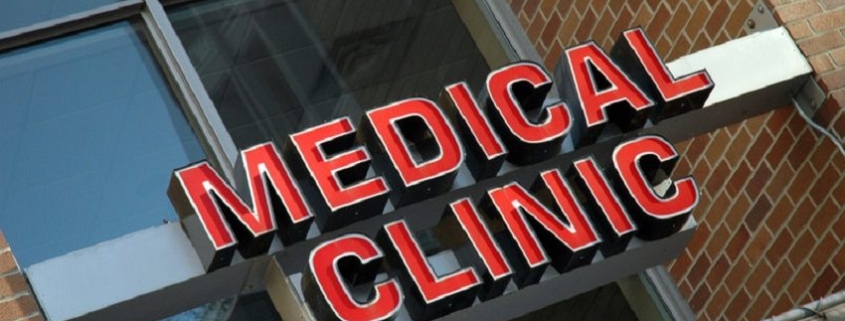Amazon’s New Prime Offer: Delivering Six Health Clinics For 20,000 Workers In Dallas-Fort Worth
Amazon is getting into the health care delivery business, at least for its employees.
Last month, the e-commerce giant opened a primary care clinic in Irving and soon plans to open similar health centers in Coppell, Garland, Duncanville, North Fort Worth and near Haslet. The local launch is the first stage of a pilot project that will include four other U.S. metros by early next year, Amazon said.

Registered nurse Jodyne Schlachter explains the technology in one of the clinical rooms at the new Amazon health center in Irving. Amazon plans to open five additional clinics in North Texas this year.(PHOTO CREDIT: Ben Torres / Special Contributor)
Depending on results in Dallas-Fort Worth, Phoenix, Louisville, Detroit and San Bernardino, Calif., Amazon could eventually expand the clinics to additional employee hubs.
The project was conceived over a year ago, before COVID-19 emerged. Officials said the coronavirus has had little effect on their plans, except to put even more emphasis on virtual health visits.
Amazon’s centers will be staffed by Crossover Health, a California company that operates onsite and near-site facilities for some large self-insured employers, including Microsoft, Facebook and LinkedIn. The clinics will include doctors, nurses, chiropractors, physical therapists and behavioral health experts.
Amazon has about 20,000 employees in North Texas and has been growing rapidly here. About 11,000 work in operations and fulfillment centers, and the rest are corporate staff, management and tech workers.
Amazon is hardly a pioneer in this space. Walmart unveiled its own health clinics in 2014, charging $4 for a doctor’s visit for employees and $40 for store customers.
Amazon clinics will be limited to employees and their dependents. To accommodate so-called Amazonians on late shifts, the centers will have extended hours, including weekends.
“Hopefully, we’re within 10 miles of almost everybody who works for Amazon in the D-FW area,” said Derek Rubino, senior program manager for workplace health and safety. “Amazon was proud to offer health insurance to all full-time employees on their first day, including hourly workers. But many in D-FW don’t use the benefit. A lot of it really comes down to convenience. Having benefits only gets you part-way there.”
Amazon wants to remove barriers that keep workers away and persuade them to embrace primary care. That includes a range of services, from check-ups and immunizations to managing chronic conditions. Studies show primary care helps avoid more complicated, costly problems later.
“I honestly believe this is going to be life-changing for some folks,” Rubino said.
Onsite clinics are usually embraced by large employers and often were started to address workplace injuries. More recently, companies have adopted them for general medical care, putting clinics near the workplace, not inside it.
In 2017, one-third of companies with at least 5,000 employees had a general medical clinic at or near their worksite, according to a survey by Mercer, a human resources consultant. That share was twice as high as a decade earlier.
“The vast majority of these clinics have done very well, both in meeting their financial objectives as well as improving health and wellness,” said Larry Boress, executive director of the National Association of Worksite Health Centers.
Companies cite many reasons for investing in clinics, from lowering health spending to boosting worker productivity.
“Over 40% of employees who use the clinics don’t have a personal doctor,” Boress said, “and in the Mercer survey, more than 1 in 3 said the clinics served as their medical home. These clinics often become their only source of medical care.”
Health advocates, employers and insurers are emphasizing primary care as a way to bend the curve in health spending. In Plano, to encourage city employees to go to certain doctors, the health plan charges a copay of just $5 for a visit. In Fort Worth, it’s free for city employees to use certain clinics or virtual health providers — but there’s a stiff penalty for going to the ER if it’s not an emergency.
The Amazon health centers are in-network providers so employees will pay the standard rate, which depends on the health plan they’ve chosen. Amazon officials would not provide a number or range. On Amazon’s benefits website, the price of an in-network office visit is $30.
“We wouldn’t drive anyone away because of price,” Rubino said.
Crossover Health, which started in 2010, said employers save 30% on health spending through its program. One reason is that it claims to cut urgent care visits and imaging services by half.
During the pandemic, Crossover said it has shifted 90% of interactions to virtual care, and secure messaging — emails and texts between patients and providers — is up 40%.
“We can identify things that may be important to a specific population and really tailor the program,” said Dr. Stephen Ezeji-Okoye, Crossover’s chief medical officer. “The extended hours, the range of services, the coverage of young dependents — all that was designed for Amazon employees.”
Crossover also emphasizes short waits, usually fewer than five minutes, to see a doctor. Visits last 30 minutes or more, in part because doctors aren’t reimbursed on a fee-for-service basis.
“Crossover gets a monthly payment, based on a per-member fee or a cost-plus arrangement,” Ezeji-Okoye said, “and that keeps the focus on keeping patients healthy. The long encounters lead to fewer tests and imaging and fewer referrals because we have the time to establish a relationship.”
“While many companies and providers are rethinking their approaches to health care, Amazon’s move could have an outsize influence,” said Boress of the worksite trade group. “Employers like to benchmark themselves against the leading edge companies. They look to the leaders, and in many cases, they follow ’em.”
Source: The Dallas Morning News




